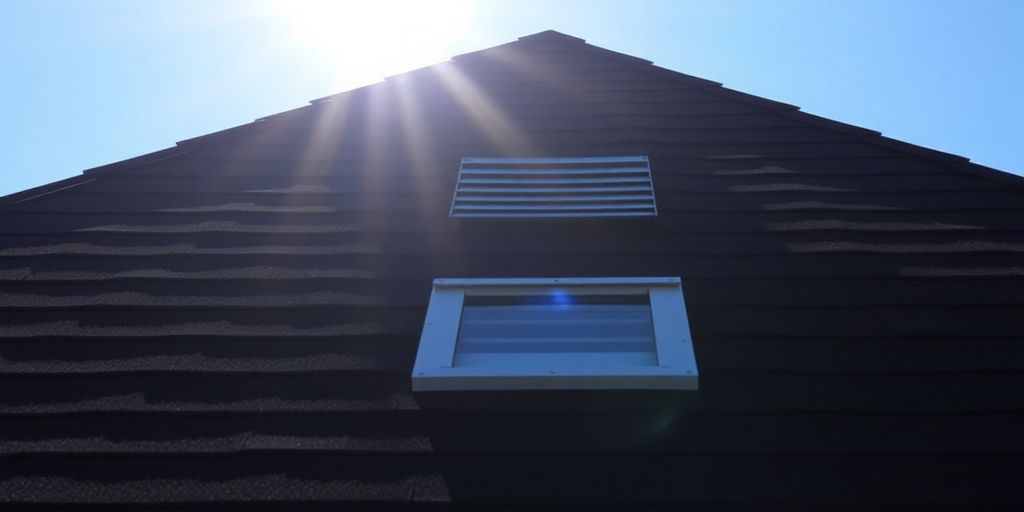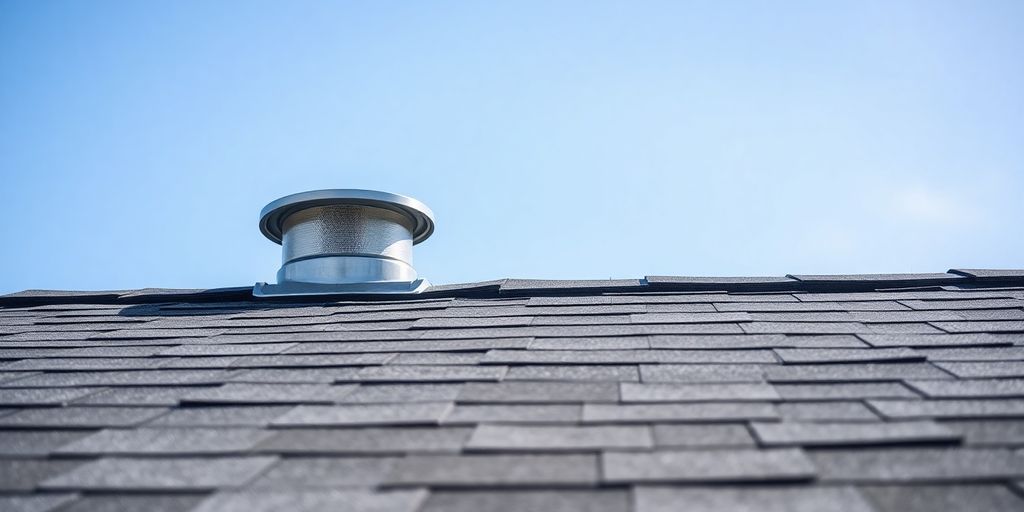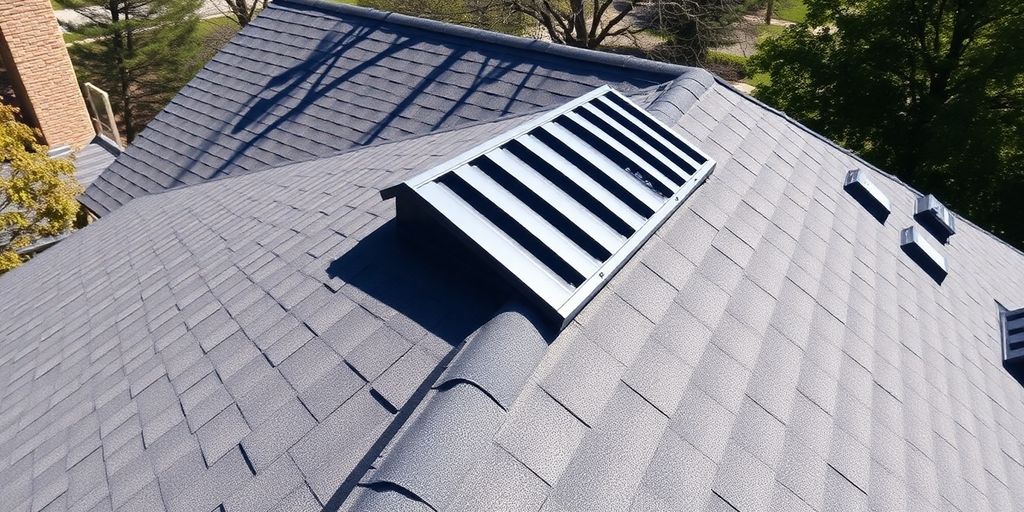Ever wonder how some houses seem to stay cooler in summer and drier in winter, even with the same weather? A lot of that has to do with what’s happening *on* the roof. Specifically, how the attic space is ventilated. One of the best ways to keep your attic happy and your roof in good shape for longer is by installing a roof ridge vent. It’s a simple addition that makes a big difference, and we’re going to break down why.
Key Takeaways
- A roof ridge vent is a vent installed along the very peak of your roof. Its main job is to let hot air and moisture escape from your attic space.
- Proper attic ventilation, like that provided by a roof ridge vent, helps keep your roof materials from getting too hot or too damp, which can make them last longer.
- By allowing hot air to escape, a roof ridge vent helps regulate attic temperatures, which can lower your energy bills by reducing the load on your heating and cooling systems.
- A well-ventilated attic prevents moisture buildup, which in turn stops mold, mildew, and wood rot from forming within your roof structure.
- While DIY is possible, getting a professional to install your roof ridge vent ensures it’s correctly placed and sized for your home, maximizing its benefits and protecting your roof.
What Is a Roof Ridge Vent?
A roof ridge vent is a type of vent installed along the very peak, or ridge, of your roof. Think of it as a continuous opening that runs the length of your roofline, just below the top edge. Its main job is to let hot, moist air trapped in your attic escape. This is a passive system, meaning it doesn’t use fans or electricity; it relies on natural air movement.
Definition and purpose of a roof ridge vent.
Essentially, a ridge vent roof is a low-profile ventilation system designed to work with soffit vents (located under the eaves) to create a natural airflow. Hot air, being lighter, rises and exits through the ridge vents, while cooler, fresh air is drawn in through the soffit vents. This continuous cycle helps keep your attic temperature more stable and reduces moisture buildup. It’s a pretty simple concept, but it makes a big difference for your roof’s health. Many homeowners opt for a metal roof ridge vent or a steel roof ridge vent for durability.
How it functions compared to box vents, gable vents, etc.
Unlike box vents, which are individual units placed on the roof surface, ridge vents offer a more continuous and often more effective ventilation path along the entire peak. They’re generally less noticeable from the ground too, which is a plus for many. Gable vents, on the other hand, are installed in the gable end walls of the attic. While they provide ventilation, they don’t create the same kind of consistent airflow from bottom to top that a ridge vent system does. The effectiveness of ridge vents can also be influenced by their design, like whether they have baffles to help direct airflow and keep out debris. A properly installed roof ridge vent cap is key to its performance.
Proper attic ventilation is a key component in maintaining your home’s overall efficiency and health. It’s not just about comfort; it’s about protecting the structure of your roof from damaging elements like moisture and extreme heat. A well-ventilated attic can lead to significant savings on energy costs over time, making it a smart investment for any homeowner. Consider looking into roof ridge vent installation for your home.
Why a Roof Ridge Vent Is Essential for Roof Health
Think of your attic like a car parked in the sun on a hot day. Without any way for that trapped heat to escape, it gets incredibly stuffy and hot inside, right? Your roof works similarly. Without proper ventilation, heat and moisture can build up in your attic space, and that’s really bad news for your roof’s lifespan and the overall health of your home.
Moisture and heat problems without proper ventilation.
When hot, humid air gets trapped in the attic, it has nowhere to go. This trapped moisture can condense on the underside of your roof decking and insulation. Over time, this constant dampness creates a perfect environment for mold and mildew to grow. Not only is this bad for your indoor air quality, but it can also lead to wood rot in your attic’s framing, which is a serious structural issue. In colder months, this same heat buildup can cause snow on your roof to melt and then refreeze at the eaves, creating ice dams that can damage your gutters and shingles. Excessive heat also bakes your shingles from the inside out, making them brittle and shortening their life considerably.
How a roof ridge vent balances airflow in the attic.
A roof ridge vent works with soffit vents (usually located under the eaves) to create a natural airflow system. Hot air, being lighter, rises and naturally exits through the ridge vent at the highest point of your roof. As this warm air escapes, it pulls cooler, fresh air in through the soffit vents. This continuous exchange of air helps to keep the attic temperature more consistent with the outside temperature, preventing that damaging heat and moisture buildup. It’s like giving your attic a constant, gentle breeze. This balanced airflow is key to preventing the problems we just talked about, keeping your roof structure sound and your shingles in good shape for longer. It’s a simple, passive system that makes a big difference in protecting your home.
Types of Roof Ridge Vents and Their Advantages

When it comes to keeping your attic ventilated, there are a few different types of ridge vents you might come across. Each has its own way of working and its own set of perks.
Steel Roof Ridge Vent
These are pretty common and usually made from galvanized steel or aluminum. They’re built to last and can handle a good amount of weather. Steel ridge vents are known for their durability and resistance to rust and corrosion. They’re often exposed, meaning you can see them along the roof’s peak, and they do a solid job of letting hot air out. Because they’re metal, they tend to be pretty sturdy, which is good if you get strong winds or heavy rain. They’re a good choice if you want something that will hold up for a long time.
Metal Roof Ridge Vent
Metal ridge vents are very similar to steel ones, often using the same materials like aluminum. The main difference is how they’re designed to fit with different roofing systems, especially metal roofs themselves. They’re designed to integrate smoothly with metal roofing panels, providing a continuous ventilation path along the highest point of the roof. This ensures that heat and moisture can escape effectively without compromising the roof’s weatherproofing. They are generally quite efficient and can be a great option for homes with metal roofing.
It’s worth noting that most ridge vents fall into two main categories based on their design: shingle-over or exposed. Shingle-over vents are hidden under special ridge cap shingles, giving a cleaner look. Exposed vents, like many metal ones, are visible and often considered more robust. You also have baffled and unbaffled options. Baffled vents have internal shields to stop rain and debris, which is a nice bonus, especially if you live somewhere with rough weather. Choosing the right type often depends on your roof’s style, your climate, and what you’re looking for in terms of appearance and performance.
Benefits of Installing a Roof Ridge Vent
Putting in a roof ridge vent isn’t just about having a fancy-looking roof peak; it actually does a lot to keep your whole roofing system in good shape. Think of it as a way to help your roof breathe, which is pretty important for its long-term health.
Extends shingle lifespan by reducing heat.
Your shingles can really take a beating from the sun, especially during those hot summer months. When your attic gets super hot, that heat transfers down to the shingles. This constant heat exposure can make them brittle and prone to cracking over time. A ridge vent helps let that super-heated air escape, keeping the attic temperature more moderate. This means your shingles don’t have to deal with as much extreme heat, which can really help them last longer. It’s like giving your roof a bit of a break from the constant baking.
Prevents mold, mildew, and wood rot.
Attics can get pretty damp, especially if you live in a humid area or if there are small leaks. When warm, moist air gets trapped in the attic, it can condense on the cooler surfaces, like the underside of your roof decking or the rafters. This moisture is a perfect setup for mold and mildew to start growing. If left unchecked, mold and mildew can lead to wood rot, which is a serious structural problem. A ridge vent works by allowing that moist air to escape, replacing it with drier outside air. This constant air exchange helps keep the attic dry, significantly cutting down the chances of mold, mildew, and the dreaded wood rot taking hold. It’s a simple way to protect the structural integrity of your home and keep the air inside healthier too. Proper roof ventilation can lower cooling costs by up to 15%, according to the U.S. Department of Energy, and also helps keep your insulation dry and effective, improving heat retention by up to 25%.
Professional Installation of a Roof Ridge Vent
Why correct placement and sizing matter.
Getting the placement and size right for your ridge vent is a big deal. If it’s not put in the right spot, or if it’s too small for your attic’s needs, it just won’t do its job properly. Think of it like trying to breathe through a tiny straw when you need a big gulp of air. The vent needs to run along the entire peak of your roof, usually, and the opening cut into the roof deck needs to be just right – not too big, not too small. This ensures that hot, moist air can escape freely without letting in rain or snow. Professionals know how to measure your attic space and roofline to figure out the exact amount of ventilation you need. They also know where the vent needs to go to work with your soffit vents to create that good airflow.
Mistakes to avoid during installation.
When installing a ridge vent, there are a few common slip-ups that can really mess things up. One big one is not leaving a little wiggle room between vent sections; materials can expand and contract, and if they’re packed too tight, they can buckle. Another mistake is putting it in crooked. It looks bad, sure, but it can also affect how well it works. To avoid this, some installers nail one side down first, then the other, to keep it straight. Also, be careful not to drive the nails too deep. If the nail head sinks too far into the vent material, it can create a spot where water can get in. Using the wrong kind of nails is another problem; you need specific nails for the vent itself, not the ones you use for regular shingles. And don’t forget to properly secure the ridge cap shingles over the vent – you need a couple of nails on each side to keep them from blowing off in high winds.
Maintaining Your Roof Ridge Vent
Once your ridge vent is installed, it’s not exactly a ‘set it and forget it’ kind of deal. You’ll want to keep an eye on it. Regular check-ups, maybe once a year or so, are a good idea. Look for any loose shingles around the vent, or any signs of moss or algae growing on it. The most important thing is to make sure it’s not blocked. Leaves, twigs, ice, or any other gunk can pile up in there and stop air from moving. If you notice debris, you can carefully clear it out. Sometimes, if you have trees hanging over your roof, you might need to trim them back to stop so many leaves from falling onto the vent. For a really thorough check, it’s always best to have a professional roofer take a look during their regular inspections. They can spot issues you might miss and make sure everything is working as it should.
Conclusion – Roof Ridge Vent as a Long-Term Investment

So, we’ve talked a lot about how roof ridge vents work and why they’re good for your roof’s health. But let’s get down to brass tacks: is it really worth the investment? Think of it this way: your roof is a big deal, and keeping it in good shape saves you a ton of headaches and cash down the road. A ridge vent is like a small, but mighty, guardian for your entire roof system. It’s not just about keeping things cool in the summer; it’s about preventing moisture buildup that can lead to rot and mold, which nobody wants. Plus, by keeping your attic temperature more even, it helps your HVAC system run better, saving you on energy bills. That’s a win-win, right? It’s a proactive step that pays off over time.
Wrapping It Up: Your Roof Will Thank You
So, there you have it. Adding a ridge vent might seem like a small thing, but it really makes a difference in how long your roof lasts and how comfortable your home stays. At Taylor Roofing, we know that proper ventilation helps keep things cool in the summer and dry all year round, which means less wear and tear on your shingles and structure. Plus, it can even help lower your energy bills a bit. It’s a pretty straightforward upgrade that doesn’t need a ton of fuss, and once it’s on, it basically takes care of itself. Think of it as a simple way to protect your biggest investment – your home – and avoid bigger headaches down the road. It’s definitely worth considering if you want a healthier, longer-lasting roof, and Taylor Roofing is here to help make it happen.
Frequently Asked Questions
What exactly is a roof ridge vent?
A roof ridge vent is a special vent installed along the very top edge of your roof, called the ridge. Its main job is to let hot air and moisture escape from your attic, helping to keep your attic space cool and dry.
How does a roof ridge vent help my roof?
Ridge vents work by allowing hot, moist air to rise and exit the attic naturally. This creates a continuous flow of air, pulling cooler air in from lower vents (like soffit vents). This process helps prevent heat buildup and moisture problems, which can damage your roof and make your home uncomfortable.
Can a roof ridge vent really make my roof last longer?
Yes, ridge vents can help extend the life of your roof. By keeping the attic cooler and drier, they reduce the stress on your shingles caused by heat and moisture. This can prevent them from cracking or deteriorating too quickly, meaning your roof lasts longer.
How do ridge vents help prevent ice dams?
Proper attic ventilation, including ridge vents, helps keep temperatures more even. This can stop ice dams from forming in winter, where snow melts and then refreezes at the edge of the roof, causing damage. By letting warm air escape, it helps keep the roof surface colder, reducing melt and refreeze cycles.
Do roof ridge vents require a lot of upkeep?
Ridge vents are generally quite low-maintenance. They don’t have moving parts, so they don’t need electricity. Usually, all that’s needed is an occasional check to make sure no debris is blocking them and that they are still sealed properly.
Will installing a ridge vent save me money on energy bills?
Yes, ridge vents can improve your home’s energy efficiency. By letting hot air escape the attic in the summer, your air conditioner doesn’t have to work as hard. In the winter, a drier attic helps your insulation work better, keeping your home warmer and reducing heating costs.

